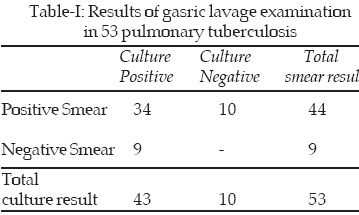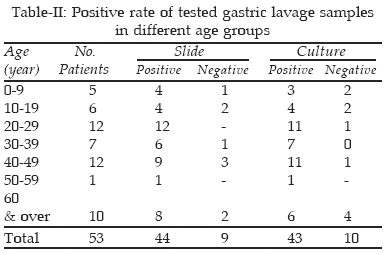|
|
||||
|
Published by : PROFESSIONAL MEDICAL PUBLICATIONS |
||||
|
ISSN 1681-715X |
||||
|
||||
|
- |
||||
|
ORIGINAL ARTICLE |
||||
|
- |
||||
|
Volume 23 |
January - March 2007 |
Number 1 |
||
|
|
||||
|
|
||||
|
|
||||
|
Published by : PROFESSIONAL MEDICAL PUBLICATIONS |
||||
|
ISSN 1681-715X |
||||
|
||||
|
- |
||||
|
ORIGINAL ARTICLE |
||||
|
- |
||||
|
Volume 23 |
January - March 2007 |
Number 1 |
||
|
|
||||
|
|
||||
Value of gastric lavage for diagnosis
of pulmonary tuberculosis
Mohammad Rahbar1, Masood Hajia2
ABSTRACT
Objective: To evaluate the sensitivity of gastric lavage specimen for observation of acid fast bacilli and isolation of mycobacterium in patients proved to be suffering from pulmonary tuberculosis.
Patients and Methods: A total number of 886 hospitalized patients in different hospitals of Urmia City were tested for pulmonary tuberculosis. Fifty-three patients were eventually enrolled in the study and one gastric lavage specimen was taken from each patient.
Results: Among these fifty three, 44 had positive gastric lavage results and 43 were positive on culture, while both positive results of smear and culture were matched in all patients proved to be suffering from pulmonary tuberculosis. The highest positive rate was in 20 to 49 and 20 to 29 years for the culture and smear respectively but the lowest culture positive rate was in those patients who were in children and those over 60 years of age.
Conclusion: Gastric lavage can be a valuable alternative specimen instead of sputum for diagnosis of tuberculosis in children and elderly patients if both smear and culture results are applied.
KEY WORDS: Gastric Lavage, Pulmonary Tuberculosis.
Pak J Med Sci January - March 2007 Vol. 23 No.1 51-53
1. Dr. Mohammad
Rahbar
2. Dr. Masood Hajia
1-2: Damavand Ave
Bo-Ali Hospital,
Reference Laboratories of Iran,
Department of Microbiology,
P.O. Box: 17115-365
Tehran – Iran.
Correspondence:
Dr. Mahammd Rahbar
E-Mail: mhhf_rz@yahoo.com
* Received for Publication: November 11, 2005
* Accepted: August 26, 2006
INTRODUCTION
Tuberculosis (TB) is today considered as the most important health problem especially in developing countries. It is estimated that one third of the world’s population (almost 95% from developing countries) is infected with Mycobacterium tuberculosis, Accurate diagnosis of pulmonary tuberculosis is still under investigation and value of different samples are being discussed.
1 The diagnosis of pulmonary tuberculosis in children and elderly people is based mainly on clinical and radiographic features supplemented by a positive history or contact and tuberculin test results.2 Bacteriological confirmation of TB in children is very difficult to achieve because of the difficulty in collecting sputum.3 In this study we evaluated the gastric lavage specimen in different age group patients to find out the possibility of its use as alternative specimen in children and elderly patients.PATIENTS AND METHODS
A total number of 886 hospitalized patients suspected to have pulmonary tuberculosis who were admitted in different hospitals of Urmia city, from May 1998 to February 2003 were registered. Among these patients only 53 were selected for inclusion in the study based on the smear results of the sputum samples, culture and X-ray confirmation. The inclusion criteria was based on:
1. Two smear-positive sputum
2. One smear positive sputum One smears positive sputum with isolation of organism from culture.
4Specimens: Gastric lavage samples were collected from each selected patient in the early morning after overnight fasting. These samples were sent to health reference mycobacteriology laboratory. Gastric lavage specimens were taken by inserting levine collection tubes through a nostril.
5 Patients were instructed to swallow the tube. A syringe was attached to the end of the tube when it was fully inserted to collect 20 to 30 ml Gastric secretions. These samples were used for microscopic examination and culture.Decontamination procedure: Specimens were decontaminated by modified Petroff ‘s method using equal volume of 4% NaOH.
6Microscopic examination and culture: Smears were directly prepared to stain by Zeihl-Nelsen method for each specimen. In addition, all specimens were inoculated onto 2 slops of Lowenstein–Jensen and incubated at 35ºC. Slops were examined for growth of M. tuberculosis for 8 consecutive weeks.
6 Suspected colonies were examined for Acid Fast bacilli with Zeihl-Nelsen methods and confirmed by biochemical tests.RESULTS
Pulmonary tuberculosis was proved in 53 patients out of 886 on the basis on applied criteria in this study. Number of positive smears from gastric lavage specimens were 44 in which culture was positive in 34 cases and negative in the rest 10 samples. Nine smear negative samples had also positive culture results.

Pulmonary tuberculosis in different age groups: Culture positive results were studied in different age groups. The highest positive rate was in 20-49 years old, but the lowest culture positive rate was in those patients with 60 years old (6 out of 10) and children.

DISCUSSION
We studied the value of gastric lavage specimens in diagnosis of pulmonary tuberculosis. Each patient had one sputum smear positive at least. One collected gastric lavage specimens was examined by direct examination for acid-fast bacilli (AFB) and culture. The yield of AFB and culture were 44/53 (83.01%) and 43/53 (81.13%) respectively. Comparison of the yield of combined AFB and culture in all patients proved to be suffering from pulmonary tuberculosis revealed 100% sensitivity, while these two methods were matched with each other in 34/53 (64.15%) of cases (Table-I). It is reported that sputum smear negative patients may have positive smear in gastric lavage
7 but the yield of AFB has not been fully investigated on patients with sputum smear. In one study the yield of one sputum smear is reported to be similar to three gastric lavage and reported to have higher efficiency in children.8The yield of AFB results could be increased if more than one gastric lavage sample is examined as it is used in primary diagnosis of TB by sputum specimens. Rizvi
9 has reported that the yield of AFB increased to 90% on direct smear of gastric lavage when results of first and second sample were combined.We expected all positive smears to have positive culture results too. Our investigation proved that long delay occurred from collecting samples to sending it to the laboratory because samples had been collected from hospitalized patients in different area of the city. None of the samples was neutralized by sodium bicarbonate after collection. Mycobacterium is sensitive to gastric acid and will become inactive after long exposure. It is reported that if sodium bicarbonate was added to gastric lavage sample, yield of AFB will be increased.
6 Analysis of results reveal that none of the AFB and culture methods were able to provide 100% sensitivity in all age group patients except AFB in 20-29 years old. The highest sensitivity rates of the culture were in adults 20-49 years old. It seems sensitivity of gastric lavage to be lower in these two groups compared with other patients. It has been recommended that gastric lavage can be a suitable alternative sample for sputum.10,11CONCLUSION
Gastric lavage can be a valuable alternative specimen if combination of AFB and culture is to be considered. However, further studies are needed to confirm the findings of this study.
REFERENCES
1. Woods G. The mycobacteriology laboratory and new diagnostic techniques. Infect Dis Clin North Am 2002;16:127-43.
2. Perez-Guzman C, Vargas MH, Torres-Cruz A. Does aging modify pulmonary tuberculosis? A meta-analytical review. Chest 1999;116:961-7.
3. Pozniak AL, MacLeod GA, Ndlovu D. Clinical and chest radiographic features of tuberculosis associated with human immunodeficiency virus in Zimbabwe. Am J Respir Crit Care Med 1995;152:1558-61.
4. Escreet BC, Cowie RL. Criteria for the diagnosis of pulmonary tuberculosis. S Afr Med J 1983;63(22):850-4.
5. Chritie JD, Donald. The Laboratory diagnosis of mycob acterium disease. Clin Lab Med 1995; 15:279-303.
6. Collins CH, Grange JM, Yates MD. Tuberculosis bacteriology, organization and practices. Butterworth Heiemann press 2nd Ed 1997;50-68.
7. Okutan O, Kartaloglu Z, Kilic E, Bozkanat E, Ilvan A. Diagnostic contribution of gastric and bronchial lavage examinations in cases suggestive of pulmonary tuberculosis. Yonsei Med J 2003;30(44):242-8.
8. Zar HJ, Hanslo D, Apolles P, Swingler G, Hussey G. Induced sputum versus gastric lavage for microbiological confirmation of pulmonary tuberculosis in infants and young children: A prospective study. Lancet 2005;365:130-4.
9. Rizivi N, Rao NA, Hussain M. Yield of gastric lavage and bronchial wash in pulmonary tuberculosis. Int Tuber Lung Dis 2001;2:147-51.
10. Berean K, Roberts FJ. The reliability of acid fast stained smear of gastric aspirate specimens. Tuber Lung Dis 1988;70:151-2.
11. Somu N, Swaminathan S, Paramasivan CN. Value of bronchalveolar lavage and gastric lavage in the diagnosis of pulmonary tuberculosis. Tuber Lung Dis 1995;76:295-9.
HOME | SEARCH | CURRENT ISSUE | PAST ISSUES
Professional
Medical Publications
Room No. 522, 5th Floor, Panorama Centre
Building No. 2, P.O. Box 8766, Saddar, Karachi - Pakistan.
Phones : 5688791, 5689285 Fax : 5689860
pjms@pjms.com.pk